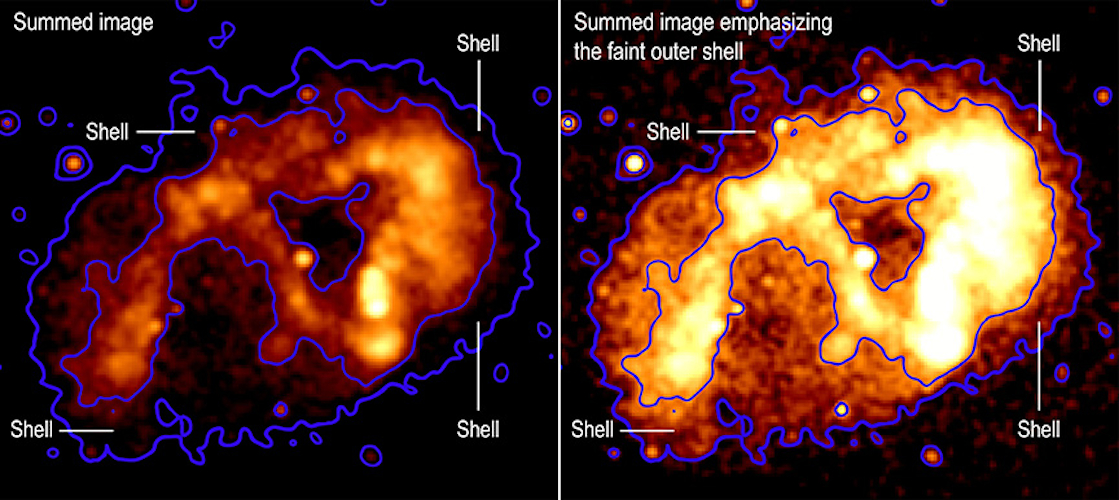
 Credit: NASA/SAO/GSFC/M. Corcoran et al.
Credit: NASA/SAO/GSFC/M. Corcoran et al.
A Blast from a Great Eruption
The nearby, supermassive doomed star Eta Carinae is surrounded by a bipolar nebula of gas and dust called the Homunculus by imaginative astronomers because of its apparent similarity in ground-based telescopes to a small humanoid.
We know by watching the expansion of the Homunculus that the nebula was created during an explosion, the "Great Eruption", which started in the 1840's and lasted about a decade, perhaps the most astounding astronomical event of the 19th century. The Homunculus is enormously massive, containing by some estimates enough matter to create 40 stars with the mass of our Sun. It's not clear what caused this massive stellar eruption, or how the star apparently survived the explosion. Beyond the Homunculus, Eta Carinae is surrounded by smaller bits of matter apparently ejected from the star over a period of centuries. Early X-ray observations, starting with the Einstein X-ray Observatory, showed that these ejecta form what appears to be a broken ring around the star, with hot, shocked, X-ray emitting gas at temperatures in excess of a few million degrees. The high-resolution X-ray cameras on the Chandra X-ray Observatory provide the most detailed look at this hot gas. Starting in 1999, and continuing over the past two decades, Chandra has monitored Eta Carinae, and the combination of all these observations provides the most sensitive image yet obtained of the outer debris. This combined X-ray image reveals that the hot, X-ray emitting gas actually forms a uniform, ellipsoidal shell around the star, filled with hot gas. The image on the left shows the X-ray bright, broken ring around the star, while on the right, the fainter, ellipsoidal shell from the combined Chandra images can be clearly seen. The blue contour lines highlight both the bright and faint emission (and some other X-ray bright stars too). The deep Chandra image suggests that this ellipsoidal shell of hot gas was produced by an elliptical blast wave from the Great Eruption, and that this blast wave collided with clumps of gas expelled by the star over the last 800 years, making them glow in X-rays. The long time baseline of the Chandra images, and their high spatial resolution, also reveal for the first time the spatial expansion of the X-ray nebulae, and show how the X-rays have gotten fainter over time. Projecting backward in time, these data suggest that, at the time of the Great Eruption of 1840, Eta Carinae would have been one of the brightest sources in the X-ray sky as seen from earth.
Published: October 2, 2023
<
HEA Dictionary ● Archive
● Search HEAPOW
● Other Languages
● HEAPOW on Facebook
● Download all Images
● Education ● HEAD
>

Each week the HEASARC
brings you new, exciting and beautiful images from X-ray and Gamma ray
astronomy. Check back each week and be sure to check out the HEAPOW archive!
Page Author: Dr. Michael F. Corcoran
Last modified Monday, 26-Feb-2024 17:47:52 EST


